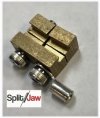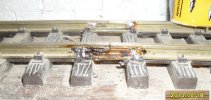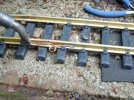With soldering large pieces of metal absolute cleanliness of the metal is
critical! Mechanically polish the brass until it is shiny-bright clean - fine steel wool or a rotary wire-brush tool in a dremel (or similar) is good for that.
You will also need a good metal flux.
This one from Screwfix is good.
Lastly, with code 332 brass rail you will need a
lot of heat. A 70W soldering iron might do the job if you have everything else just about perfect, but is probably not the best place to start.... you'd need a higher rated iron with a big tip.
On the rare occasions when I have personally needed to solder to code 332 brass rail I have used a resistance soldering unit rather than a soldering iron, and I know that others have had success using butane gas torches .
Lastly, instead of soldering directly to the rail, have you considered using rail clamps around the track and soldering eyelets to the end of your feeder wires which are then put under the screws on the rail clamp? The photo below is just one example, there are a number of different rail clamps on the market.
View attachment 340085



